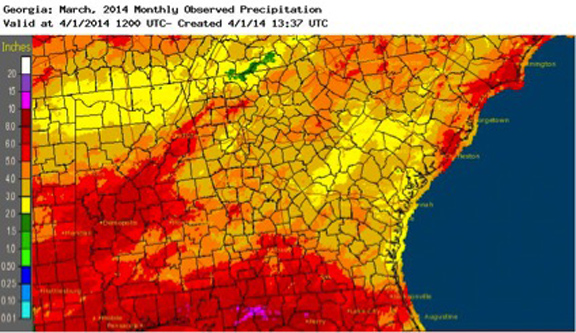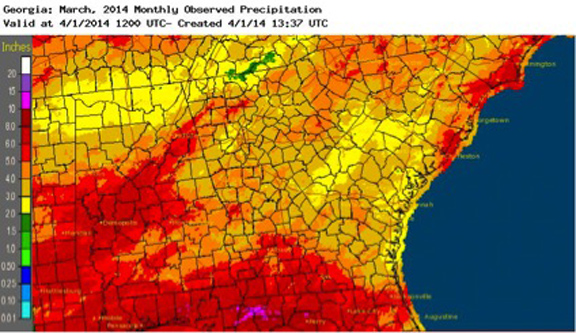March in Georgia was fairly calm, but colder than normal across the entire state with temperatures ranging from between 2 to 4 degrees below average.
The relatively late cool temperatures may reduce the size of individual Vidalia onions this year, but the weather should not affect overall yields. Peaches received some frost damage late in the month due to temperatures that fell into the 20s, but it was not clear how significant the damage was at month’s end.
Wheat growers noted that powdery mildew was observed across the state, especially in the southwest, but it is expected to diminish as temperatures warm up and relative humidity drops. Some farmers held off planting watermelons and other summer field crops late in the month until after the cold temperatures passed.
In Atlanta, the monthly average temperature was 52.5 degrees (1.8 degrees below normal); in Athens it was 51.5 degrees (2.8 degrees below normal); in Columbus it was 54.7 (3.1 degrees below normal); in Macon it was 52.8 (4.0 below normal); in Savannah it was 56.6 (2.6 below normal); in Brunswick it was 57.9 (2.4 below normal); in Alma it was 55.9 (4.3 below normal) and in Augusta it was 51.8 (4.1 below normal).
Augusta reported a record low daytime high temperature of 39 degrees on March 4, breaking the old record of 40 degrees set in 1893. Brunswick set a record low daytime high temperature of 49 degrees on March 7, breaking the old record of 53 set in 2013. A record low temperature of 26 degrees was felt in Macon on March 26, breaking the old record of 28 degrees set in 2006. Alma reported a 31 degree low the same day, breaking the old record of 34 degrees, also set in 2006.
Brunswick reported a record low daytime high temperature of 53 degrees on that date, as well, breaking the old record of 58 degrees set in 2013.
The highest monthly total precipitation recorded by a National Weather Service reporting station was 5.4 inches in Columbus (.06 inches below normal), and the lowest was recorded in Brunswick with 2.54 inches (1.34 inches below normal). Atlanta received 3.12 inches (1.69 below normal). Macon received 3.93 inches (.62 below normal). Alma received 3.22 inches (1.53 below normal). Augusta received 2.56 inches (1.50 below normal). Athens received 3.37 inches (1.06 below normal), and Savannah 2.65 inches (1.08 below normal).
The highest single-day rainfall recorded by a Community Collaborative Rain Snow and Hail network volunteer was 3.99 inches near Lake Park in Lowndes County on March 17, with observers in Donalsonville and Valdosta reporting 3.95 and 3.91 inches on the same day, respectively. The highest monthly total rainfall recorded by a CoCoRaHS volunteer was 9.39 inches, observed east of Thomasville in Thomas County, followed by 8.63 inches measured by another Thomasville observer. No snow totals were reported in March, but snow flurries were seen in north Georgia on March 25, according to a CoCoRaHS observer there.
Because of the drier than normal weather, abnormally dry conditions returned to parts of Georgia, according to the National Drought Monitor. The drier soil helped farmers get into the fields to do spring field work, but they are concerned that the soil may be too dry to support germination if there’s no more rain before planting begins.
There was only one day with severe weather reported in March. This occurred on March 16, with wind damage to trees and power lines across southern Georgia.








